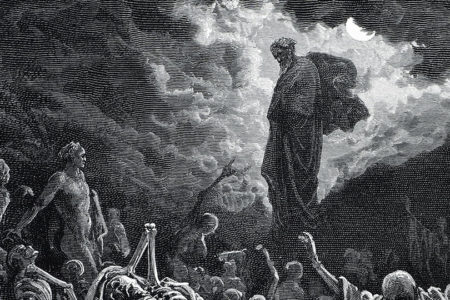Homeward Bound
The United States of America was built by immigrants. In the earliest days, they came from England, Holland, and Spain, often seeking freedom from religious persecution. Germans, Poles, Swedes, and many other peoples came for other reasons, such as work in the burgeoning industry and business opportunities. Jews also came as part of the succession of nationalities that swept onto the shores of the new nation for many and varied reasons and made America the melting pot it is today.
Israel has experienced a similar situation. It too has been built through the immigration of people from many lands. They have come for various reasons, most often to escape the fires of intense anti-Semitic persecution. A strong bond pulls them together into that one little, sovereign, democratic state located at the eastern end of the Mediterranean Sea.
Causes for Jewish Immigration to Israel
Three basic reasons cause worldwide Jewry to return to the land of Israel. The first is the age-old devotion of the Jewish people to their historic homeland and the hope of messianic redemption. Their land was given to them by divine decree. According to Moses, the land belongs to those who had been in bondage in Egypt (Gen. 15:13–18).
The second cause is the horrible conditions under which they have lived in other nations—pogroms (massacres) in Russia, the Holocaust of Nazi Germany, and present-day hardships in Russia and other Eastern European countries.
The third cause is the very active Zionist minority, who are convinced that the only fundamental and lasting solution to the Jewish problem is a return to the homeland.
These reasons, seen in the light of Ezekiel 36 and 37, lead to the conclusion that immigration to Israel and the establishment of its statehood form the greatest miracle of the 20th century.
Natan Sharansky was a Soviet “prisoner of conscience” for nine years until his release in 1986. He now lives in Jerusalem. Referring to the present return of Russian Jews to Israel, he recently said, “We are living through biblical times. We are the people who left Egypt. We came to Israel. We were exiled to Babylon; some of us came back. Then we were exiled again. We were exiled from Spain; we were exiled from Germany. All our history is migrations.
“Never in our history has anything happened like what is happening today … In three to five years, Israel will be home to an additional million, perhaps two million or more Jews … In the next decade the Russian chapter in Jewish history will end. That event changes not only the fate of Soviet Jews but also the fate of Israel and of Jews all over the world.”1
Immigration Prior to Israel’s Statehood
Although there has always been a Jewish population in Palestine, the first modern-day return to the land came in the 1880s. As a result of the pogroms in Russia and Hungary, along with blood libels (alleged ritual murders of Christian children by Jews and the use of their blood in making unleavened bread for Passover), a handful of early Jewish settlers returned to the homeland.
Early in the 20th century more Jewish people returned to Israel, and urban life began, particularly in Jaffa. During the ensuing years, immigration fluctuated, based on the political situation in the world, the White Papers (severe limitation of immigration by Jews to Israel imposed by Great Britain), and Arab pressure on the British.
By 1931 clouds hung over Europe, and life became almost impossible for European Jews. Chaim Weizman, who eventually became the first President of State of Israel, reported that the world was divided into “places where they [Jews] cannot live” and “Places where they [Jews] could not enter.”2 Their only refuge was Palestine, where, in 1933, a Jewish community of more than 200,000 was ready to welcome them. But because the British curtailed most immigration until the end of the British Mandate and the statehood of Israel in 1948, only a few thousand Jews escaped the claws of Nazi Germany. Even after Germany’s defeat, only 750 Jews a month were permitted to enter Palestine.
Immigration Following Statehood
A total change occurred in immigration policies following Israel’s declaration of statehood in 1948. The Israeli Declaration of Independence reads, “The State of Israel will be open to Jewish immigration and the ingathering of the exiles.” The doors were swung open for any and all Jewish people to come home, provided that they met the requirements of the Law of Return established in 1950.
Between May and August 1948, 25,000 immigrants who had been detained on Cyprus by the British arrived in Israel, even while the War of Independence raged. In the first year of statehood, 203,000 Jews returned home. This mass immigration continued until the end of 1951, when it dropped off considerably.
Mass Immigrations
During the brief history of the tiny nation of Israel, there have been several mass immigrations.
In 1949 the Jews of Yemen were gripped by a messianic sensitivity. On foot, carrying all their worldly possessions on their backs, they made their way to the seaports. When the Israeli government learned of their actions, they agreed to bring them to Israel, and Operation Magic Carpet began. Within a relatively short time, approximately 47,000 Yemenite Jews were flown home, as on eagles’ wings, leaving only about 300 behind.
In 1950 and 1951 more than 100,000 Iraqi Jews were taken to Cyprus and then on to Israel by air and sea in Operation Ezra and Nehemiah.
There have been six major waves of immigration to Israel. Five are complete, and the sixth is still occurring, and at a very rapid pace. The first five waves were as follows: (1) May 1948 to 1951, 755,000 from around the world; (2) 1955 to 1957, 162,000 from Morocco, Tunisia, Poland, and Romania; (3) 1961 to 1964, 215,000 from North Africa and Eastern Europe; (4) 1967 (following the Six-Day War), 262,000 from North and South America, Europe, and the Soviet Union; and 5) 1977 to 1992, 41,800 from Ethiopia.
The origin of the Ethiopian Jews reportedly goes back to the time of the Queen of Sheba (see 1 Ki. 10; 2 Chr. 9). They obviously predate New Testament times because their religious practices do not include later rabbinical practices. The account of Philip and the Ethiopian eunuch in Acts 8 indicates that some were proselytes to Judaism at that time.
The return of the Ethiopian Jews has been unusual. From 1977 to 1989 about 17,000 came to Israel, including 7,000 who came by sea and air in Operation Moses in 1984 and 1985. From 1990 through May 23, 1991, another 8,800 came to Israel. The last major group came in May 1991 via Operation Solomon, when 14,000 were brought to Israel by air in less than two days. This immigration left only 2,600 Jews in Ethiopia, most of whom have come to Israel since then.
But the Ethiopian Jews who immigrated to Israel have not been without their problems. “A year after Operation Solomon, Israel’s Ethiopian immigrants are mired in difficulties. They have faced isolated incidents of racism, but these pale in comparison with housing and job problems, and what they consider to be patronizing treatment at the hands of authorities.”3
Since learning the Hebrew language, however, they have actually been absorbed into the society of Israel much better than their Russian counterparts. They are better able to handle the menial jobs than the Russians, who have more technical and scientific training. It is hoped that the Ethiopian immigrants will be totally assimilated into the Israeli society within a few years.
Russian Jewish Immigration
“Nobody really knows how many Jews live in the Soviet Union; estimates range from 1.5 to 4 million. Many of them, preferring not to stand up and be counted, changed their names and hid their heritage to avoid having ‘Jew’ stamped into their internal passports. During three centuries of czarist rule and 73 years of communism, that stamp has often meant persecution.”4 The Jewish people of Russia are seeking to leave as rapidly as they can, believing that while the door is open they should not hesitate. Meanwhile, Jews remaining in Russia feel that whenever relations with other nations are friendly, the Russians want something. They believe that the laws regarding Jewish emigration were relaxed only to satisfy the Americans because the Russians want trade and credit with the West. The Jews believe that it is only a matter of time before Russia looks for a scapegoat for their worsening economy, and they are afraid they will become that scapegoat. Each day the Jews who remain in Russia expect something to happen, being unconvinced that the “democratization” of Russia is a guarantee of their future security. They have witnessed the rise of Pamyat, a Nazi-type hate group, and are watching as the desecration of synagogues and cemeteries increases.
When the doors first opened for Jews to leave Russia for Israel, only a trickle went, joining the group of “refuseniks” who had escaped earlier. That trickle, however, soon turned into a flood. The numbers involved give an idea of the complexity of the situation Israel faces. Immigration figures for the last five years are as follows: 1988, 2,173; 1989, 12,918; 1990, 185,000; 1991, 145,000; 1992, 65,000.5
Israel has taken in more than a half million Russian Jews in the last several years. Percentage wise, this would be like the United States taking in more than 30 million immigrants in a few years.
Problems Resulting From Mass Immigration
Although aliyah (immigration of Jews to Israel) has been the lifeblood of the State of Israel since its inception in 1948, it has created many new challenges and problems. Absorption of the immigrants proved to be a major problem. How do you bring together people from more than a hundred nations and blend them into a new culture? How do you teach the Hebrew language to millions of people who speak different languages? Food, housing, education, health care, and various other things usually taken for granted were not available.
Employment was also a major problem. The new citizens had to be put to work, even if it was at menial, low-paying tasks. Many scientists, doctors, and other professional people were reduced to sweeping streets.
Jerusalem is a prime example of the current job situation. More than a thousand Russian immigrants flood into the city each month, and they all need employment, but few jobs are available. Furthermore, most of these people are technically well-trained, but the language barrier creates a problem. Many are forced to do menial tasks for low wages, and some simply cannot find work. Housing presents another problem. Hotels are often pressed into temporary service, along with other temporary shelters, while new villages are constantly under construction. A few years ago, the Israeli government requested of the United States a ten-billion-dollar loan guarantee for the sole purpose of providing housing for new immigrants. This request was at first turned down but was eventually granted.
Future Immigration?
Uri Gordon, head of the Aliyah Department of the Jewish Agency, recently wrote an article entitled “It’s Time for Every Jew to Come Home to Israel.”6 In it he maintains that Israel bases its immigration policy on a solemn principle: Israel will offer a haven to any Jew who wishes to live there.
He further states, “There remains just one large pocket of Diaspora [Jews in dispersion] left: the North American continent.” His call is for them to come home. He envisions a Jewish population in the State of Israel of seven to eight million in the near future, contending that North American Jews cannot support Israel from afar.
God is doing something miraculous in the land of Israel in our day. As the church apostatizes and sin abounds, Christians should be looking up. If God is doing at present what He promised to do—bringing Israel home—can it be long before the Lord Jesus returns?
ENDNOTE
- Moment Magazine, February 1991.
- Israel Pocket Library, “Immigration and Settlement” (Jerusaelm: Keter Publishing Housem 1973), 30-31.
- Jerusalem Report, May 7, 1992.
- Insight, May 21, 1990.
- Jerusalem Report, February 11, 1993.
- The Jerusalem Post (International Edition), January 12, 1991.








